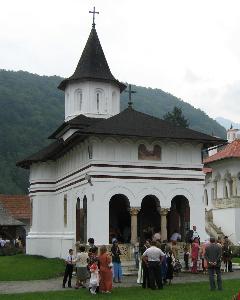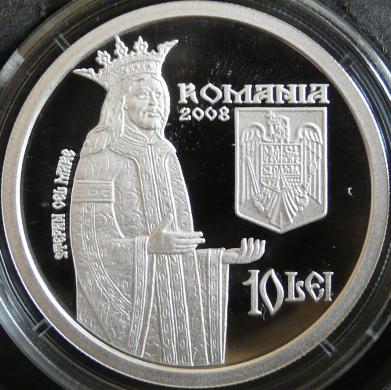
|
10 lei 2008 - monasteries of Cozia, Voroneț and Sîmbăta de Sus |
|
The 10 lei 2008 coins pictures above are present on the site through the permission of an anonymous donor. These pictures, like all other pictures displayed on Romanian coins / Monede românești, cannot be used in any circumstances to illustrate auctions or sales and cannot be posted on other web page without the permission of the owner.
These three coins belong to the Christian Feudal Art Monuments series. To the same series belong the 500 lei from 2002 gold coins with Bistrița Monastery (from Moldavia), Mogoșoaia Palace and with Colțea Church, another two silver coins of 500 lei issued in 2004 bearing the images of the Three Hierarchs church in Iași and of the Cotroceni church in Bucharest, one silver coin of 5 lei issued in 2006 with the wooden church of Ieud-Deal, three silver coins of 10 lei issued in 2011 with the church of Strei and monasteries of Humor and Hurezi and the 10 lei 2013 silver coin with the wooden church of Rogoz.
About Cozia Monastery
The church of Cozia Monastery, founded by Walachian voivod Mircea the Old, was erected between 1387 and 1388. The founder dedicated the church to the Holy Trinity, and donated lands, villages, vineyards, mills and salt mines. In several contemporary documents Cozia was also named Nucet (Cozia being the translation of the Romanian word Nucet - meaning walnut tree forest - into the Turkic language of the Cumans - information after Constantin Giurescu). The fresco representing Mircea and his son Mihail in the pronaos is probably the one painted in the 14th century.
About the votive painting of Cozia church
|
Here is the description of the image of Mircea from Cozia, description made by Romanian historian Constantin Giurescu in his book Istoria românilor (History of the Romanians, 5th edition, 1946, reprinted in 2007): The ruler is dressed with a tight costume, red coloured, with blue flowers. The tunic, not very long and hemmed with gold thread, has the lower part open in front. Near the knees are embroided the imperial eagles - an influence not necessarily directly Byzantine, but maybe from the court of Bulgarian or Serbian rulers. The red footwear has pointed tips, after the Polish fashion. Above the suit, Mircea wears a gold hemmed mantle, fastened on one side, on the right shoulder. The waistline is pressed by a thin girdle. A short sword, fastened into a larger belt, hangs in front, to the right. On the head the ruler wears the crown with five points.” Mircea the Old was burried at Cozia. The inscription on his tombstone was completely erased during the centuries. |
  |
|
About Voroneț Monastery The stone church of Voroneț, dedicated to Saint George, was built by Stephen the Great and the Holy. The construction was erected between May 26th and September 14th 1488, so the coin celebrates 520 years since the building of the Voroneț church. The votive painting representing the founders of the church, Stephen the Great, his wife Maria, their son Bogdan and one of their daughters offering the building to Saint George and to Jesus Christ, was painted in 1496. The Voroneț Monastery is older than 1488; previously here was a church made from wood. The paintings on the outer walls were added in 1547, year when the porch was also built. These improvements were ordered by Grigore Roșca, the metropolitan of Moldavia. |
  |
About Sîmbăta de Sus Monastery
The monastery of Sîmbăta de Sus [literally, Upper Saturday] was built in Transylvania sometime between 1696 and 1698 by Constantin Brâncoveanu, the ruler of Walachia. The tradition, recorded by the "pomelnic" of the monastery (a list of names of dead predecessor and of their relatives used in requiem masses for their repose), shows that the building replaced an older wooden church (before the name of Constantin Brâncoveanu there are three other names, probably the names of the founders of the older church). Sîmbăta de Sus is placed in Transylvania, in the valley of River Sîmbăta in the old Country of Făgăraș. Constantin Brâncoveanu, a great founder and defender of the Orthodoxy, tried to stop the religious union of the Transylvanian Romanians with the Catholics. The churches established in Transylvania by Constantin Brâncoveanu supported the Orthodox Christians, always persecuted in that time for his faith.
In 1782 the imperial court of Vienna ordered the disbanding of all religious orders inside the Austrian Empire. As a consequence, in 1785 the monastery and the church of Sîmbăta de Sus were destroyed by Habsburg troops, as reprisals for the refuse of the monks to accept the religious union with Rome. Metropolitan Nicolae Bălan, considered the second founder, reestablished the monastery in 1926, the church being finished in 1928. The nowadays enceinte of the monastery, with the cells built in Brâncovenian style, was erected between 1985 and 1993 through the perseverence of Antonie Plămădeală, metropolitan of Ardeal, Crișana and Maramureș who, as the third founder, was buried at Sîmbăta de Sus.



|
Back to selection page!
|





